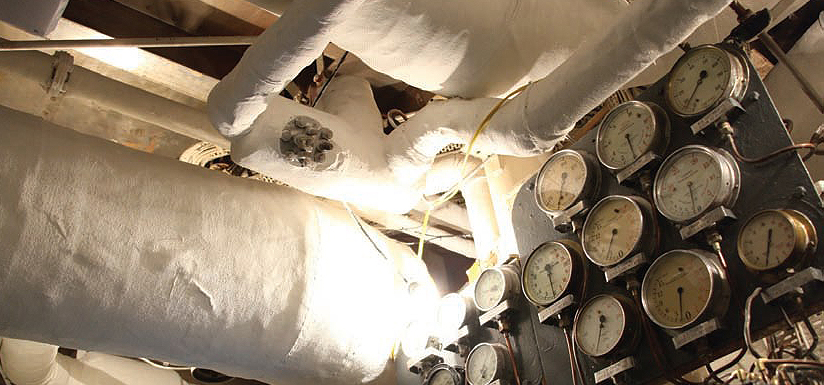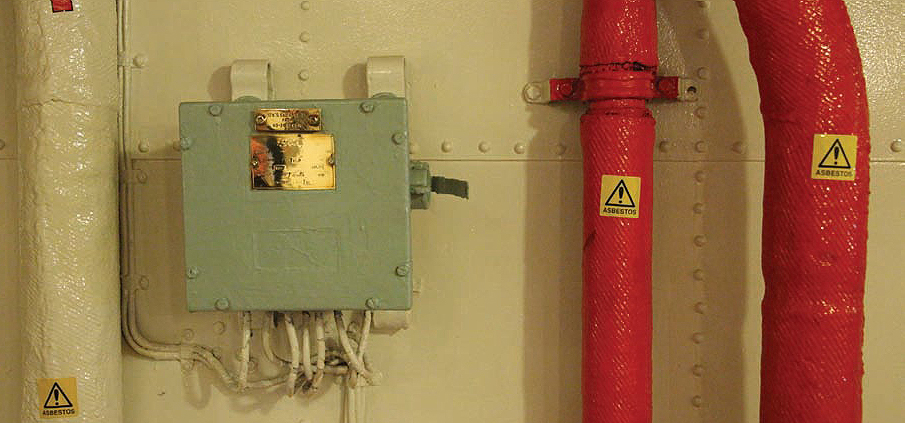- Topics
- Campaigning
- Careers
- Colleges
- Community
- Education and training
- Environment
- Equality
- Federation
- General secretary message
- Government
- Health and safety
- History
- Industrial
- International
- Law
- Members at work
- Nautilus news
- Nautilus partnerships
- Netherlands
- Open days
- Opinion
- Organising
- Podcasts from Nautilus
- Sponsored content
- Switzerland
- Technology
- Ukraine
- United Kingdom
- Welfare
Historical harm: new hopes for seafarers affected by asbestos exposure
26 April 2018

Many seafarers have suffered from asbestos exposure. Stephen Burbidge ‒ a partner in Humphreys & Co, solicitors specialising in asbestos claims ‒ considers a recent court decision which should open the door to more victims and their families getting compensation…
Most claims for compensation for asbestos exposure causing lung disease involve claimants exposed to asbestos in the 1950s to 1980s. By the 1950s, a broad range of items were being manufactured using asbestos – from paper, yarn and cloth through to cement, pipe and insulating material and wall tiles.
Sprayed asbestos, now known to be extremely hazardous to health, was extensively used in the British Royal Dockyards from the Second World War to 1963, when its use was discontinued. The most hazardous types of asbestos, blue asbestos (crocidolite) and brown asbestos (amosite) were used widely to produce insulation boards and hot pipe and boiler lagging, and it was not until 1972 and 1980 that their importation stopped. In 1999 the importation of white asbestos (chrysotile) was banned.
In these decades, many merchant seafarers were exposed to asbestos to a greater or lesser extent. Ships' engineers routinely worked in enginerooms and boiler rooms amongst a complex network of asbestos-lagged pipes, usually in a dusty, poorly-ventilated atmosphere, regularly knocking into pipes lagged with asbestos causing airborne dust and fibres, without any effective respiratory protection.
Sometimes, the engineers cut into or hacked off lagging to carry out their work, and at other times they worked in the vicinity of laggers who mixed blue asbestos powder with water to make a paste that was applied to the boilers and pipes to insulate them. Those serving on ships importing raw asbestos, typically contained in open-weave hessian sacks that were often broken or insecure, could also be exposed if supervising the cargo holds or assisting in the unloading of cargoes when the ship was docked.
With exposure occurring decades ago, you might think that by now the law in relation to asbestos claims must be settled. Nothing could be further from the truth. The last 25 years have seen considerable development in the law. That's because, typically, asbestos-related lung disease does not manifest for about 30 to 50 years after exposure.
So why is the law in a state of flux? After all, the law of negligence has been around since the 1930s and the various regulations governing workers exposed to asbestos have been known about for years. It's because asbestos claims are valuable.
A diagnosis of mesothelioma has a devastating impact on a sufferer and their family. In the UK, mesothelioma alone accounts for over 2,500 deaths a year, and a single mesothelioma claim might result in an award of compensation of £100,000 to £300,000 – sometimes more. Overall, insurers are paying out hundreds of millions of pounds each year on compensation claims involving asbestos-related diseases.
There has always, therefore, been a substantial incentive for insurers to put forward arguments that will defeat not only a single claim, but significant numbers of claims within a class. This has meant that over the years asbestos claims have been a fertile ground for appeals.
Examples include Fairchild v Glenhaven Funeral Services [2003] 1 AC 32, in which it was argued by insurers that, as a matter of principle, mesothelioma sufferers exposed to asbestos with multiple employers could not succeed in their claims, as they would be unable to prove which of the employers was at fault (with the House of Lords then formulating a new test in mesothelioma cases to enable claimants to gain justice).
Then, in Barker v Corus plc [2006] UKHL 20, insurers successfully argued that compensation for mesothelioma should be apportioned between culpable employers – an injustice that had to be reversed by the government passing the Compensation Act 2006.
Low exposure cases
The latest area of attack has been in low exposure cases. It has always been easier to prove liability in cases involving heavy exposure to asbestos. Laggers – those using spray asbestos or those cutting insulation boards with electric circular saws – typically inhaled heavy concentrations of airborne asbestos dust and fibres, and would be most at risk of developing actionable conditions such as diffuse pleural thickening, asbestosis, mesothelioma and asbestos-related lung cancer. Most such claimants would be likely to succeed in proving a breach of duty by their employer. But a large number of cases involve activities that give rise to far lower fibre concentrations and exposures of much shorter duration.
In 1965 an article in the Sunday Times made it widely known for the first time that it was not only workers exposed to substantial amounts of asbestos who were at risk of developing conditions like asbestosis; those exposed to light and intermittent quantities of asbestos were themselves at risk of developing serious pulmonary conditions like mesothelioma.
Thus, since the courts have always applied the standards of the day when assessing negligence claims in industrial disease cases, exposure up to 1965 needed to be substantial if a breach of the common law duty of care was to be proved. Exposure post-1965 needed simply to be more than negligible.
In 2011, though, the insurers scored a significant victory in Williams v University of Birmingham [2011] EWCA Civ 1242. The claimant, Michael Williams, was just 54 when he died of mesothelioma. His widow brought claim against the university where he had studied from 1970 to 1974 because during that period he had carried out experiments in a service tunnel containing pipes that were lagged with asbestos. The judge who heard the initial case found that the lagging was in poor condition, Mr Williams was exposed to asbestos (albeit in fairly low concentrations) and there had been a material increase in the risk that he would develop mesothelioma as a result.
Compensation was therefore, according to the judge, payable by the university. The insurers then appealed to the Court of Appeal, which found that the judge had failed to consider the question of whether it was reasonably foreseeable that Mr Williams would suffer mesothelioma, and that this needed to be proved in his case. When addressing that issue, the court said the best guidance available at the time was a Technical Data Note (TDN13) which was published in 1970 to help the Factory Inspectorate decide when to prosecute under the Asbestos Regulations 1969.
High and low exposure to asbestos can both pose serious risks ‒ a principle established by a Sunday Times article in 1965.


TDN13 set out threshold levels of asbestos fibre concentrations which, if exceeded, would prompt a prosecution. TDN13 was therefore adopted by the court as a yardstick for when the reasonable employer should take steps to implement precautions such as masks, respiratory protection and dust extraction equipment, to reduce dust concentrations to 'safe' levels.
This decision has, since 2011, presented a signify can't hurdle to be overcome by claimants in low exposure cases, and has sadly deprived many sufferers and their families of compensation for their conditions – so it was a victory for defendants' insurers. It also created a situation where, in many cases, it was easier to prove breach of duty in earlier years (when less was known about asbestos and its dangers) than in later years.
Bussey v Anglia – providing help to claimants
The Williams finding has now at last been challenged in the Court of Appeal, in the case of Bussey v Anglia Heating [2018] EWCA Civ 243. David Bussey was employed by the defendant from 1965 to 1968, during which time he installed central heating systems and boilers. This work exposed him to asbestos when he cut through asbestos cement pipes with a hacksaw, used asbestos rope to caulk joints and swept up dust and debris.
In February 2015, Mr Bussey developed mesothelioma, and this led to his premature death in January 2016. His widow then brought a claim for compensation which was defended. The court, hearing the case in April 2017, dismissed the claim on the basis that – although the exposure postdated the Sunday Times article of 1965 – the levels of exposure fell below those in TDN13 which were found in Williams to be 'safe'. The court considered that it was bound by that decision and the claim therefore had to fail.
Mrs Bussey then appealed to the Court of Appeal and her appeal has in 2018 now been allowed. However, the court declined to find that the Williams case was, as a matter of principle, decided wrongly. It found that where a worker's exposure to asbestos was variable and the employer could not know the extent of the exposure, the employer had to assess the risks of 'the maximum possible exposure'. The employer could only ignore the risk if none of the employees would be sufficiently exposed to be at risk.
Importantly, the court found that TDN13 was a 'relevant consideration' but 'not determinative of every case'. The court expressly said that Williams was not a binding decision that TDN13 established 'safe' levels of asbestos exposure for the period from 1970 to 1976, and less so for any period before 1970.
This is a positive development for claimants seeking to recover compensation in low exposure asbestos cases, and at last reintroduces some realism to the analysis as to what was properly and fairly considered to be safe in the 1970s onwards in terms of exposure to asbestos. Insurers will undoubtedly continue to argue that account should be taken of the thresholds in TDN13 (this decision does not extinguish those arguments entirely) but it is now very clear that TDN13 is no longer to be regarded as the yardstick.
The overall prospects of low exposure cases succeeding should now improve for claimants.
Tags
